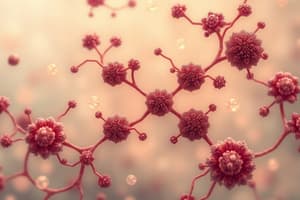Podcast
Questions and Answers
Pain and stress can decrease the amount of drug absorbed because of the autonomic response to ______.
Pain and stress can decrease the amount of drug absorbed because of the autonomic response to ______.
pain
The drug distribution is the process by which the drug is delivered from the systemic circulation to body ______ or target cells.
The drug distribution is the process by which the drug is delivered from the systemic circulation to body ______ or target cells.
tissues
Biotransformation is the process by which a drug is enzymatically converted to a simpler compound or ______.
Biotransformation is the process by which a drug is enzymatically converted to a simpler compound or ______.
deactivated
The most important excretion routes are through the kidney and ______.
The most important excretion routes are through the kidney and ______.
Most drugs are eliminated in the ______, so elimination is highly influenced by its function.
Most drugs are eliminated in the ______, so elimination is highly influenced by its function.
Kinetics means 'movement' and deals with a drug’s actions as it moves through the ______.
Kinetics means 'movement' and deals with a drug’s actions as it moves through the ______.
The ______ effect occurs when the drug is exerting its maximum effect.
The ______ effect occurs when the drug is exerting its maximum effect.
Absorption covers a drug’s progress from the time it’s administered until it reaches ______ circulation.
Absorption covers a drug’s progress from the time it’s administered until it reaches ______ circulation.
The condition of the ______ can affect drug absorption by metabolizing much of the drug before it enters circulation.
The condition of the ______ can affect drug absorption by metabolizing much of the drug before it enters circulation.
Increased blood flow to the absorption site improves drug ______.
Increased blood flow to the absorption site improves drug ______.
Flashcards are hidden until you start studying
Study Notes
Pharmacokinetics Overview
- Kinetics refers to the movement and action of drugs through the body.
- Involves four main processes: absorption, distribution, metabolism, and excretion (ADME).
Absorption
- Absorption is how a drug enters the bloodstream after administration.
- All administration routes, excluding intravenous, require absorption.
- Onset of action is the time for a drug to reach its minimum effective concentration.
- Peak effect occurs when the drug is at maximum effect and concentration.
- Duration of action is how long the drug remains effective above the minimum concentration.
Factors Affecting Absorption
- Route of Administration: Determines the speed of absorption (oral, sublingual, inhalation, subcutaneous, IM).
- Gastrointestinal Condition: Conditions such as surgical removal of the small intestine can impair absorption.
- Liver Function: Drugs absorbed in the small intestine are partially metabolized by the liver before entering circulation (first pass effect).
- Blood Supply: Increased blood flow enhances absorption; decreased blood flow reduces it.
- Pain and Stress: Can diminish absorption due to the body's autonomic response.
- Drug Formulation: Different forms (tablets, liquids, slow-release) affect absorption rates.
Distribution
- Distribution is the delivery of drugs from systemic circulation to tissues and target cells.
- Influenced by blood flow; drugs reach well-perfused organs more quickly.
- Solubility affects distribution; lipid-soluble drugs can cross cell membranes and the blood-brain barrier, while water-soluble drugs cannot.
Metabolism
- Also known as biotransformation, this process converts drugs into simpler compounds or deactivates them.
- Primarily occurs in the liver, which can be affected by liver disease and age.
- Lifestyle factors, such as smoking and alcohol use, can also impact metabolic rates.
Excretion
- Excretion refers to removing the drug and its metabolites from the body.
- Key excretion routes are the kidneys and liver; other routes include lungs (respiration), sweat, and breast milk.
- Proper kidney function is critical for drug elimination; impaired function can lead to accumulation and toxicity.
Pharmacology Fundamentals
- Pharmacology studies drugs’ effects and their interactions with living organisms.
- Branches include pharmacy (drug production), toxicology (harmful effects), and clinical pharmacology (therapeutic use).
- Nurses focus on pharmacotherapeutics, which addresses drug applications for treatment and prevention of disease.
Drug Nomenclature
- Chemical Name: Describes the drug's atomic/molecular structure.
- Generic Name: A nonproprietary name, used globally (e.g., Aspirin).
- Trade Name: The brand name given by the manufacturer (protected by copyright).
Legal Terms and Drug Classification
- Over-the-Counter (OTC) Drugs: Accessible without a prescription (e.g., acetaminophen).
- Prescription Drugs: Require a prescription due to potential side effects (e.g., antibiotics).
- Controlled Drugs: Subject to prescription regulations due to addiction risk (e.g., Valium).
Drug Sources
- Plants: Natural substances (e.g., morphine).
- Animals: Derived from animal compounds (e.g., insulin).
- Minerals: Naturally occurring elements (e.g., iron).
- Synthetic: Created in labs (e.g., ranitidine).
- Genetically Engineered: Biotechnologically developed (e.g., Hepatitis B vaccine).
Drug Actions and Side Effects
- Indications: Conditions treated by the drug (e.g., Benadryl for allergies).
- Actions: How the drug affects cellular functions.
- Contraindications: Conditions that preclude drug use.
- Side Effects: Unwanted effects that are not dangerous.
- Adverse Effects: Serious, harmful reactions (e.g., seizures).
- Interactions: Drugs/foods that can alter a drug's effect negatively.
Summary of Implications for Student Nurses
- Students should understand pharmacodynamics, pharmacokinetics, and patient safety in drug administration.
- Emphasis on medication monitoring and patient education for safe drug use.
Studying That Suits You
Use AI to generate personalized quizzes and flashcards to suit your learning preferences.




